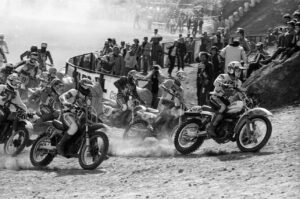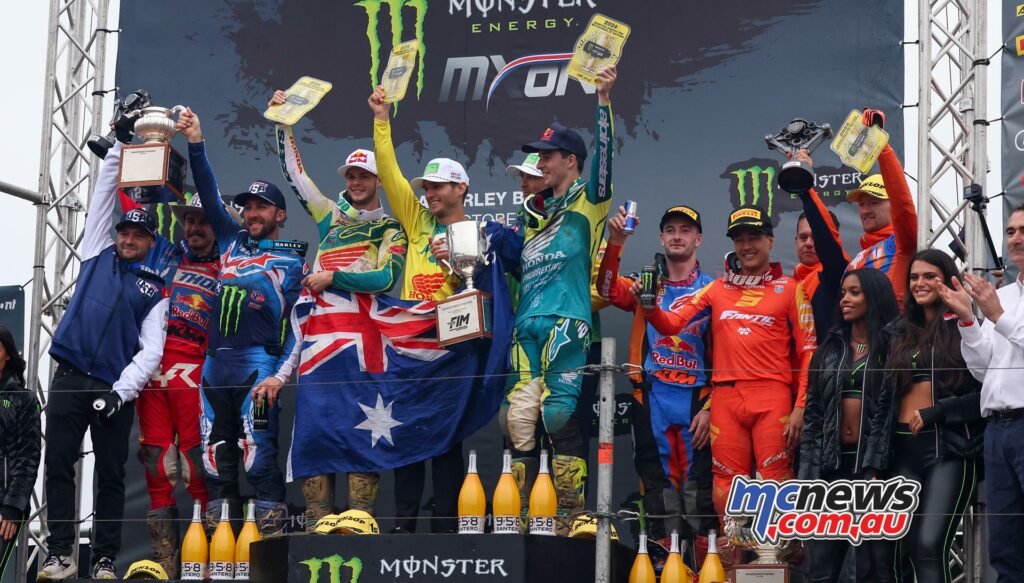Motocross fans around the world, especially those down under in Australia, had reason to celebrate this October as Team Australia clinched its first-ever victory in the iconic Motocross des Nations (MXoN), held this year at the legendary Matterley Basin in the UK. This wasn’t just any win; it was a momentous milestone that has reshaped the international narrative of the sport, proving that Australia is now a force to be reckoned with on the world stage. The 2024 win was historic in itself, but it was also significant as the Lawrence brothers, Jett and Hunter, became household names by leading Australia to victory.
While the spotlight may now be on Australia, the MXoN has a deep and storied history, filled with political twists, legendary comebacks, and rivalries with the United States. In the spirit of celebrating this landmark year, let’s dive into the origins of the race, the challenges faced by countries trying to participate, the past political hurdles that kept the U.S. out of the race, and how the Americans made an epic comeback, paving the way for a new chapter in the sport’s legacy.
The Motocross des Nations: A Global Celebration of Speed and Skill
The Motocross des Nations (often abbreviated as MXoN) has earned its nickname as the “Olympics of Motocross.” It’s a once-in-a-year spectacle where riders don’t just compete for individual glory, but for the pride of their nation. Since its inception in 1947, the race has evolved from a post-war European championship to the premier international event for motocross enthusiasts worldwide. The stakes couldn’t be higher—riders swap out their factory brand jerseys for their country’s colors, giving fans a rare chance to see their national team battle on the track.
This event’s format is unique. Each country’s team consists of three riders, representing the MXGP (450cc), MX2 (250cc), and Open classes. The riders race twice, with each race combining two different classes. Points are awarded based on finishing position, and the team with the lowest combined score emerges as the winner. It’s an event that requires skill, endurance, and teamwork, pushing riders to give their all for the ultimate goal of bringing home the title for their country.
In the early years, the event was dominated by European nations, particularly Belgium, Great Britain, and Sweden. These countries were among the first to adopt motocross as a mainstream sport, with a dedicated fanbase and some of the world’s best riders. It wasn’t until the 1980s that the United States began making its mark on the MXoN stage.
The U.S. Boycott and the Path to Dominance
While the U.S. is now a familiar name in the MXoN winners’ circle, there was a time when American riders weren’t present at all. The absence of Team USA in the 1950s and 60s wasn’t due to a lack of talent but rather a clash of priorities and politics. During these years, motocross hadn’t yet become mainstream in the U.S., where flat-track racing and later, Supercross, held more public attention. Furthermore, the logistical and financial barriers of sending American riders overseas for the event made participation difficult. These barriers, coupled with the emerging Cold War tensions, limited American participation in international motorsport events, including MXoN.

The early 1970s, however, marked a turning point. With motocross growing in popularity stateside, fueled by the success of riders like Gary Jones and Marty Smith, the U.S. began making tentative steps onto the international stage. But it wasn’t until 1981—a pivotal year for U.S. motocross—that things would truly change. At that year’s MXoN, held in Lommel, Belgium, an underdog American team comprised of Donnie Hansen, Johnny O’Mara, Chuck Sun, and Danny LaPorte stunned the world by taking the overall win against formidable European rivals.
The win in Belgium marked the beginning of a golden age for American motocross. The U.S. continued its MXoN winning streak through much of the 1980s and 90s, with legends like Rick Johnson, David Bailey, and Ricky Carmichael solidifying America’s dominance. In those years, the Americans not only developed a reputation for incredible speed and technical skill but also raised the profile of MXoN among American fans. It was no longer just another race on the calendar—it was a chance for American riders to showcase their abilities on the world stage.
The Lawrence Brothers: Leading Australia to Victory
Fast forward to 2024, and the race’s competitive landscape has changed drastically. No longer is the MXoN dominated by just one or two nations. Countries like France, Belgium, the Netherlands, and Australia are now genuine contenders, each with strong programs and talented riders. And leading Australia to its historic first-ever win are two brothers from Queensland—Jett and Hunter Lawrence.
The Lawrence brothers’ journey to motocross fame didn’t come without its fair share of obstacles. Both Jett and Hunter moved to Europe at young ages to race on the world circuit, sacrificing the comforts of home to train in challenging and unfamiliar environments. Their hard work eventually paid off, catching the attention of American teams and fans alike. Now racing in the U.S. in both the AMA Supercross and Pro Motocross series, the Lawrence brothers have become the faces of Australian motocross, representing their country with pride and talent.
At MXoN 2024, Jett’s performance in the Open class was instrumental in Australia’s victory. He secured a win in Race 2 (MX2 & Open) and followed it up with a second-place finish in Race 3 (MXGP & Open). Meanwhile, Hunter’s performance in the MXGP class was equally crucial, placing eighth in Race 1 and fourth in Race 3. These results brought down Australia’s overall score, giving them the edge over the United States and the Netherlands.
Significance of Australia’s First Win

Australia’s victory at MXoN 2024 is monumental not only for the Lawrence family but for Australian motocross as a whole. In a sport traditionally dominated by European and American teams, Australia’s win represents the arrival of a new global powerhouse in motocross. For Australian fans, this victory is more than just a trophy—it’s a testament to years of hard work, dedication, and the growth of the sport down under.
The impact of this win is expected to go beyond this one race. Australia’s success will likely inspire a new generation of riders, leading to increased investment in training programs, youth development, and motocross infrastructure in the country. The 2024 MXoN win could mark the beginning of an era where Australia not only competes but consistently contends for international motocross titles.
Team USA: Legacy, Rivalries, and the Last Decade of Challenges
The U.S. motocross legacy at MXoN is one of both pride and resilience. After their breakout success in the 1980s, Team USA went on to become one of the most decorated teams in MXoN history, capturing 23 overall wins. Riders like Jeff Stanton, Mike Kiedrowski, and James Stewart brought flair, skill, and tenacity, becoming legends in their own right.
However, the dominance of Team USA began to wane in the last decade. The increasing skill level of European teams, the emergence of top-tier riders from other countries, and changes in MXoN track conditions have all contributed to the U.S. facing tougher competition. Not to mention, international motocross has evolved, with the top European leagues cultivating a unique riding style and technical prowess that pushed Team USA to the limit. Recent years have been especially challenging, as Team USA has struggled to reclaim the glory they once held.
In 2024, Team USA came close to reclaiming their spot at the top. With Eli Tomac, Aaron Plessinger, and Cooper Webb on the roster, there was hope that the Americans could break their title drought. Tomac’s consistent finishes—second and third in his races—kept the U.S. within striking distance, but Australia’s consistent team effort ultimately edged them out.
For American fans, the past decade of near-misses is a bittersweet reminder of both the sport’s growth and the challenge of maintaining dominance in a rapidly evolving landscape. As motocross grows globally, Team USA is adapting and competing in an era where talent is spread widely across continents, rather than being centralized in just a few countries.
The Global Impact and Future of MXoN
The 2024 MXoN, held at Matterley Basin with its challenging jumps and natural terrain, was a testament to the global appeal of motocross. Fans from all over the world filled the venue, waving flags and chanting for their countries. The event is no longer dominated by a few powerhouses—it’s a truly global celebration of motocross.
With Australia now on top, we can expect to see more countries invest in their motocross programs. France, the Netherlands, Slovenia, and of course, the United States, all have talented riders and programs that could win the title in the future. The Lawrence brothers’ victory has undoubtedly set a new precedent, showing young riders around the world that, with enough dedication and grit, they too could one day win MXoN.
Conclusion: A New Era in Motocross
The 2024 Motocross des Nations represents a turning point in motocross history. Team Australia’s victory, driven by the Lawrence brothers, has sent a message that the sport is evolving, and global talent is rising to meet the challenge. For the United States, this means continuing to adapt and fight for their place at the top. For Australian fans, this victory is a dream come true, setting a new benchmark in the nation’s sporting achievements.
Motocross des Nations isn’t just another race. It’s an opportunity to witness riders from every corner of the world come together to celebrate the love of competition and national pride. As we look forward to next year’s race, the 2024 MXoN will be remembered as the year a new chapter in motocross began—one where Australia finally took its place among the elite. With each passing year, MXoN solidifies its status as the ultimate test of motocross skill, grit, and determination, promising fans that the best is yet to come.








